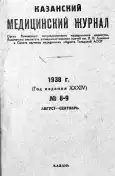О лечении папулонекротического туберкулида антивирусом Мазура
- Авторы: Медведь А.И.1
-
Учреждения:
- Казанский туберкулезный институт (директор проф. М. И. Мастбаум)
- Выпуск: Том 34, № 8-9 (1938)
- Страницы: 902-905
- Тип: Статьи
- URL: https://journal-vniispk.ru/kazanmedj/article/view/59050
- DOI: https://doi.org/10.17816/kazmj59050
- ID: 59050
Цитировать
Полный текст
Аннотация
Папулонекротический туберкулид характеризуется образованием в коже маленьких инфильтратов, величиною от просяного зерна до чечевицы, выступающих слегка над кожей, плотных на ощупь, обычно не дающих никаких субъективных ощущений, желтоваторозового цвета в свежих случаях, позднее—синеватокоричневого цвета. Локализируется этот процесс преимущественно на разгибательных поверхностях конечностей и оставляет после себя пигментированные рубчики. Сыпь высыпает не сразу, и мы видим одновременно как более молодые так и старые высыпания, рубчики и пигментации на месте исчезнувших элементов. В центре некоторых эффлоресценций отмечаются желтые точки, напоминающие пустулку, но не содержащие гноя, а некротическую массу. Эти желтые точки постепенно превращаются в серовато- коричневую корочку. Иногда папулки рассасываются бесследно, но чаще они оставляют после себя углубленный пигментированный рубчик. Впоследствии пигментация исчезает, и остаются белые рубчики. Заболевание тянется годами в виде отдельных вспышек.
Ключевые слова
Полный текст
Открыть статью на сайте журналаОб авторах
А. И. Медведь
Казанский туберкулезный институт (директор проф. М. И. Мастбаум)
Автор, ответственный за переписку.
Email: info@eco-vector.com
Россия
Список литературы
Дополнительные файлы






